Resistance training, also known as strength training, isn’t just for bodybuilders or fitness buffs. It’s an essential workout that anyone can integrate into their routine to enhance physical strength, improve health, and prevent injury. Whether you’re new to fitness or looking to build a sustainable workout plan, this guide will walk you through the basics of resistance training, its benefits, and how to get started.
What is Resistance Training?
Resistance training is any type of exercise that makes your muscles work against a force. This could be weights, resistance bands, bodyweight exercises, or even using machines in the gym. The goal is to break down muscle fibers so they rebuild stronger over time, which improves endurance, strength, and overall functionality.
Why Resistance Training Matters
Adding resistance training to your fitness routine has incredible long-term benefits, and it doesn’t require a huge time commitment. Here’s why it matters:
1. Builds Strength
Resistance training increases muscle strength, enabling you to perform daily tasks (like carrying groceries or moving furniture) more easily. Stronger muscles also improve balance, reducing the risk of falls and injuries as you age.
2. Boosts Metabolism
Muscle tissue burns more calories than fat, even at rest. Incorporating strength training helps you build lean muscle, which can significantly boost your resting metabolic rate and help with weight management.
3. Improves Bone Density
Resistance training places stress on your bones, promoting bone growth. This is particularly valuable in reducing the risk of osteoporosis, especially as you age.
4. Enhances Mental Health
Strength training has been shown to boost mood, reduce anxiety, and improve self-confidence. Plus, it offers a sense of accomplishment as you see yourself getting stronger over time.
5. Versatile & Adaptable
Resistance training is incredibly flexible. It fits all fitness levels, from beginner to advanced athletes. You can start at home with bodyweight exercises or head to the gym and use free weights or machines.
How to Get Started with Resistance Training
If you’re new to resistance training, follow these six simple steps to build a strong, sustainable foundation:
1. Set Your Goals
What’s your motivation? Whether you want to build strength, lose weight, or tone your body, identifying your goals is key. For beginners, aim for 2–3 days of resistance training per week to allow your body time to recover.
2. Choose the Right Equipment
There’s no need to splurge on an expensive gym membership or equipment to begin resistance training. Here are a few accessible tools:
- Bodyweight (e.g., push-ups, squats, planks)
- Resistance Bands (affordable, portable, and easy to use)
- Dumbbells or Kettlebells (great for progressive overload as strength increases)
- Machines (ideal for controlled movements at the gym)
Start with tools you’re most comfortable using.
3. Learn Proper Form
Proper form prevents injury and maximizes results. Always start with light weights to master each movement. Need guidance? Watching tutorial videos or hiring a certified trainer can give you the confidence to train safely.
For example:
- Squats should keep your knees aligned with your toes.
- Deadlifts should engage your glutes and hamstrings, not your lower back.
4. Focus on Compound Movements
Compound movements target multiple muscle groups simultaneously, making them efficient and effective. Start with these basics:
- Squats (legs, glutes, core)
- Deadlifts (hamstrings, glutes, lower back)
- Bench Press (chest, shoulders, triceps)
- Pull-Ups or Rows (back, biceps, shoulders)
Once you’ve mastered these fundamental exercises, you can expand to isolation exercises like bicep curls or leg extensions.
5. Progress Gradually
Progressive overload is the key to building strength. Gradually increase the weight, reps, or resistance over time to challenge your muscles and keep improving. For beginners, aim to add 5–10% more weight every 2–3 weeks.
For example:
- Week 1: 3 sets of 8–10 reps with 10-pound dumbbells.
- Week 4: Upgrade to 3 sets of 10–12 reps with 15-pound dumbbells.
6. Prioritize Recovery
Recovery is just as important as the workout itself. Ensure you’re giving your muscles 48 hours to repair and grow stronger before targeting the same muscle group again. Other recovery tips include:
- Stretching & Mobility Work to improve flexibility and prevent soreness.
- Protein Intake to aid muscle repair.
- Sleep to help your body recover fully.
Sample Beginner Workout Plan
Here’s a simple, full-body workout plan for beginners you can try at home or in the gym:
Day 1
- Bodyweight Squats: 3 sets × 12 reps
- Push-Ups (modified if needed): 3 sets × 10 reps
- Dumbbell Rows (One Arm): 3 sets × 8 reps per arm
- Plank (hold for 20–30 seconds): 3 sets
Day 2
- Rest or Active Recovery (e.g., walking, yoga)
Day 3
- Deadlifts (dumbbell or barbell): 3 sets × 10 reps
- Overhead Shoulder Press (dumbbells): 3 sets × 10 reps
- Glute Bridges (bodyweight or with a dumbbell): 3 sets × 12 reps
- Side Plank (hold for 15 seconds per side): 2 sets
Tips for Long-Term Success
- Track Your Progress
Keep a workout journal or an app to record exercises, weights, and reps. Seeing progress keeps motivation high.
- Mix it Up
Avoid plateaus and boredom by trying new workouts or swapping out exercises every few weeks. Check out platforms like Muscle & Strength for more ideas.
- Join a Community
Connecting with like-minded fitness enthusiasts can help you stay accountable and motivated. Social media groups or apps can make fitness more fun and interactive.
- Fuel Your Efforts
Nutrition matters! Pair your workouts with a well-balanced diet rich in protein, whole grains, fruits, and vegetables to fuel muscle growth and recovery.
Take the First Step
Resistance training offers life-changing benefits for both body and mind. Starting might feel intimidating, but remember—to get stronger, you just need to take that first small step. Commit today, and your future self will thank you.
Beginner looking for guidance? Visit resources like Muscle & Strength to find tailored workout programs, tips, and video tutorials to help you on your fitness journey.
You’ve got this! 💪








